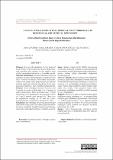Please use this identifier to cite or link to this item:
http://hdl.handle.net/11547/11611Full metadata record
| DC Field | Value | Language |
|---|---|---|
| dc.contributor.author | Çifcibaşı, Emine | - |
| dc.date.accessioned | 2024-04-25T12:48:13Z | - |
| dc.date.available | 2024-04-25T12:48:13Z | - |
| dc.date.issued | 2015 | - |
| dc.identifier.issn | 2149-2352 | - |
| dc.identifier.uri | http://hdl.handle.net/11547/11611 | - |
| dc.description.abstract | In this study, we attempt to show the reason behind the poor estimation of the future values of foreign exchange-rate (FXR) signals under difference-equation modeling, using the neural network approach for evaluating the local system coefficients. To do this, we have splitted EUR/USD and AUD/CAD signals into many small-segments and modeled each segment as the signal representation of a linear time-invariant (LTI) system using the simple linear difference equation (LDE) formulation. After a precise segmentation of each FXR signal such that an LTI system based modeling is highly accurate in each segment, it is observed that the coefficient values of the corresponding LDEs are highly volatile, which indicates that a reliable estimation would be very difficult using LDE modeling. Although the LDE coefficients are usually observed to take values within a small range over a given FXR signal segment (sample-set), frequent sudden-jumps in coefficient values do occur, which subjects/forces the dynamics of FXR signals to undertake the dynamics of these sudden-jumps rather than the dynamics of any other deterministic or stochastic process. To support this observation, the range of variation of the LDE coefficients over each segment is analyzed to quantify the volatility of the foreign-exchange market for risk assessment. | tr_TR |
| dc.language.iso | en | tr_TR |
| dc.relation.ispartofseries | 49;3 | - |
| dc.title | CLINICAL EVALUATION OF FREE GINGIVAL GRAFT SHRINKAGE IN HORIZONTAL AND VERTICAL DIMENSIONS | tr_TR |
| dc.type | Article | tr_TR |
| Appears in Collections: | Web Of Science | |
Files in This Item:
| File | Description | Size | Format | |
|---|---|---|---|---|
| ECE208F76E0C43D1B85D55F85C063501.pdf | 386.79 kB | Adobe PDF |  View/Open |
Items in DSpace are protected by copyright, with all rights reserved, unless otherwise indicated.
